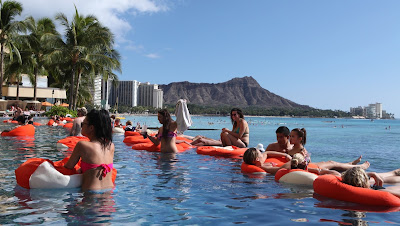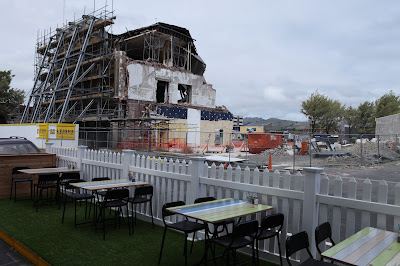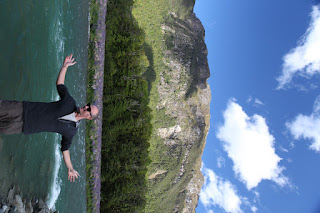The little 50 seater jet from Honolulu to Hilo was great fun. I couldn't stand upright. It took off what seemed like vertical then banked steeply squashing you into the seat. The weather was stormy which delayed us 30 minutes. The flight to the big island only took 45 minutes. You NEED to hire a car on the big island - it's more Polynesian than American, and public transport is minimal. The conversation with Avis went something like this;
Me: Hi! I'd like a car for 3 days - what's the cheapest you have?
Avis: We have a special right now - for $90 a day you could have that;
*points to bright blue convertible Mustang*
Me: *wide-eyed* ooh, I'll take the Mustang!
Avis: Great! You won't regret it!
So there I am - sitting in a purring, left-hand drive, automatic Mustang in the pitch black airport car park. I've not driven a car in over a year. I change from park to drive, release the handbrake and cruise out of the airport - ill prepared but ready for adventure - I know Volcano village is about 20 miles south-west. It's raining hard, then clears quickly leaving an incredible vista of the stars through the windscreen (shield?). I take it easy, I have no idea what this car's capable of - I notice that the traction control is on and sports mode is off - I think I'll leave it like that for the moment.
Volcano village is tiny - one general store, the lava cafe, a Thai restaurant, a petrol station and some tourist accommodation. My hostel was called HoloHolo and was hard to find down some tiny dark roads. The hostel is deathly quiet, and quite cold. In the dorm room were two US geologists studying the volcano - they were getting up at 3am the next day to go to the lava lake - something that's off-bounds to tourists. I asked if I could join them, but special permits were required.
My reason for coming to this Island was to see some lava. The geologists said that the walk from crater drive was now 7 miles over old lava terrain, and impossible if you didn't know where to look for the lava. They suggested going from the north side, but it would require a guide as it would be on private land - costing $300 on your own, or $150 in a group. Also the rain was a factor - it was constantly raining heavily. As time went on I didn't find people willing to shell out $150, and I wasn't prepared to pay $300 - so the lava idea faded.
I took a drive in the rain down crater drive, where you pass various dated lava flows. The road winds down a huge hill to the sea and then the road stops abruptly, where a 2003 lava flow decided to cross! It's from here that you can hike 7 miles to the active flow if you so wished.
I spend the last night before flying out in Hilo at a little guest house slightly out of town, called the Hilo tropical garden hostel. I meet up with two gnarly Alaskans who'd fled to Hawaii from the oppressive cold - as they (and many Alaskans) do every year. We drive up to the observatory at Mauna Kea. An interesting drive that steadily climbs and climbs and climbs, seemingly never-ending. The only indication that you're getting higher is the car using more and more fuel. We hit the clouds and heavy rain for 10 minutes then pop out into brilliant sunshine, and the observatory at around 13,000ft. From base (at the bottom of the Pacific) to the peak (33.000ft) it's twice as high as Everest (base to peak) We're not able to drive to the summit in my muscle car - this is only accessible by 4x4. There's some great little walks around the area on the red martian landscape but the wind-speed is incredible!
Me: Hi! I'd like a car for 3 days - what's the cheapest you have?
Avis: We have a special right now - for $90 a day you could have that;
*points to bright blue convertible Mustang*
Me: *wide-eyed* ooh, I'll take the Mustang!
Avis: Great! You won't regret it!
So there I am - sitting in a purring, left-hand drive, automatic Mustang in the pitch black airport car park. I've not driven a car in over a year. I change from park to drive, release the handbrake and cruise out of the airport - ill prepared but ready for adventure - I know Volcano village is about 20 miles south-west. It's raining hard, then clears quickly leaving an incredible vista of the stars through the windscreen (shield?). I take it easy, I have no idea what this car's capable of - I notice that the traction control is on and sports mode is off - I think I'll leave it like that for the moment.
Volcano village is tiny - one general store, the lava cafe, a Thai restaurant, a petrol station and some tourist accommodation. My hostel was called HoloHolo and was hard to find down some tiny dark roads. The hostel is deathly quiet, and quite cold. In the dorm room were two US geologists studying the volcano - they were getting up at 3am the next day to go to the lava lake - something that's off-bounds to tourists. I asked if I could join them, but special permits were required.
My reason for coming to this Island was to see some lava. The geologists said that the walk from crater drive was now 7 miles over old lava terrain, and impossible if you didn't know where to look for the lava. They suggested going from the north side, but it would require a guide as it would be on private land - costing $300 on your own, or $150 in a group. Also the rain was a factor - it was constantly raining heavily. As time went on I didn't find people willing to shell out $150, and I wasn't prepared to pay $300 - so the lava idea faded.
I took a drive in the rain down crater drive, where you pass various dated lava flows. The road winds down a huge hill to the sea and then the road stops abruptly, where a 2003 lava flow decided to cross! It's from here that you can hike 7 miles to the active flow if you so wished.
 |
| Lava says no to road |
 |
| A flow from early 2000 |
I spend the last night before flying out in Hilo at a little guest house slightly out of town, called the Hilo tropical garden hostel. I meet up with two gnarly Alaskans who'd fled to Hawaii from the oppressive cold - as they (and many Alaskans) do every year. We drive up to the observatory at Mauna Kea. An interesting drive that steadily climbs and climbs and climbs, seemingly never-ending. The only indication that you're getting higher is the car using more and more fuel. We hit the clouds and heavy rain for 10 minutes then pop out into brilliant sunshine, and the observatory at around 13,000ft. From base (at the bottom of the Pacific) to the peak (33.000ft) it's twice as high as Everest (base to peak) We're not able to drive to the summit in my muscle car - this is only accessible by 4x4. There's some great little walks around the area on the red martian landscape but the wind-speed is incredible!
































































